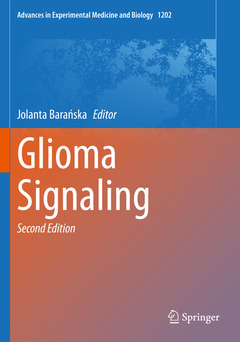Description
Glioma Signaling (2nd Ed., 2nd ed. 2020)
Advances in Experimental Medicine and Biology Series, Vol. 1202
Coordinator: Barańska Jolanta
Language: English
Subjects for Glioma Signaling:
Publication date: 08-2021
305 p. · 17.8x25.4 cm · Paperback
Publication date: 02-2020
305 p. · 17.8x25.4 cm · Hardback
Description
/li>Contents
/li>Comment
/li>
Gliomas, developing in the brain from the transformed glial cells, are a very special kind of tumor, extremely refractory to conventional treatments. Therefore, for the development of new antitumor strategies, a better understanding of molecular mechanisms responsible for their biology, growth and invasion is still needed. This book is a reference on cellular signaling processes regulating gliomas physiology and invasiveness.
The work is focused on the mechanism of nucleotide receptor activation by exogenous nucleotides and formation of complex signaling cascades induced by growth factors, cytokines and cannabinoids. The second edition of the book enriched in new chapters provides a framework explaining how signal transduction elements may modulate numerous genetic and epigenetic alterations, describes the role of local microenvironment in cellular growth, progression and invasion and, in the light of extensive new results, presents perspectives concerning potential targets for gliomas therapy.
Introduction to purinergic signaling in the brain.- Adenosine signaling in glioma cells .- Cross-talk in nucleotide signaling in glioma c6 cells.- Calcium signaling in glioma cells – the role of nucleotide receptors.- Purinergic signaling in glioma progression.- Cytoskeleton and nucleotide signaling in glioma c6 cells.- Signaling determinants of glioma cell invasion.- Receptor tyrosine kinases: principles and functions in glioma invasion.- Recent advances in understanding mechanisms of tgf beta signaling and its role in glioma pathogenesis.- Stat signaling in glioma cells.- Cannabinoid signaling in glioma cells.- Effects of arginine and its deprivation on human glioblastoma physiology and signaling.- Histone modifying enzymes and chromatin modifiers in glioma pathobiology and therapy responses.- Role of infiltrating microglia/macrophages in glioma.
These books may interest you

Glioma signaling 167.60 €

Glioma Cell Biology 158.24 €

Glioma Cell Biology 158.24 €

